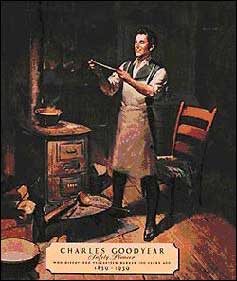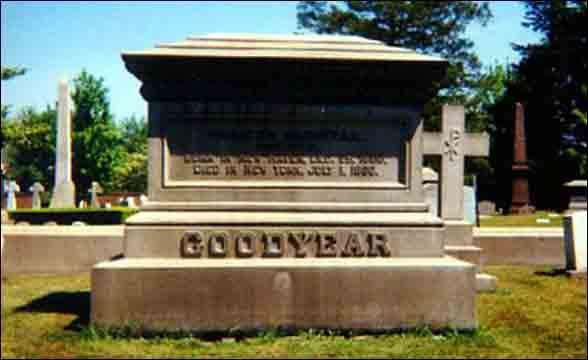IIf you have come to this page from a search engine please click here for a full site map and access to all site pages
A similar story is told in The Readers Digest of 1958, and shown on the Goodyear Corp. website. Others claim that the discovery took place in the laboratory at his house and certainly the classic picture shown above is more suggestive of a home laboratory than a shop. One ‘domestic’ story tells how: One day while holding aloft a ladle of his latest failure, Goodyear gave the mixture an angry shake. A glob flew from the ladle and landed on a hot stove. He peeled the rubber concoction off the stove and was amazed at what he had. The heat had changed it. Kneading the small piece in his fingers he found that it was now strong and elastic. And another: Goodyear had invited some friends over to show them his ball of gummy rubber. He had managed to harden it by mixing the rubber with sulphur and treating it with an acid gas. As people began to toss the rubber ball around, it accidentally landed on a hot wood stove. The rubber began to melt and Goodyear was terribly upset. However as he attempted to scrape the rubber off the stove, he discovered it had hardened to the consistence he had been trying to achieve. The process known as vulcanization had been born. Yet another ‘domestic’ story involves rubberized fabric: In one attempt to make a better rubber, Goodyear mixed rubber with sulphur and white lead, and painted the mix onto a piece of fabric. Then somebody, no one knows just who, left this piece of rubberized fabric on a hot stove top. Goodyear realized from the smell that the fabric was burning, but before he can throw out the charred remains, he noticed that the material may have charred but the rubber had not melted under all that heat as he would have expected. The problem with the ‘stove and compounded rubber story’ which is attached to Charles Goodyear is that he does not seem to be the only claimant for it! The following letter was written by Morriss Mattson MD to an American friend. It is undated but can be found in “The India Rubber and Gutta-Percha and Electrical Trades Journal” of 1887. “I have been familiar with everything relating to rubber since its first inception as an industrial interest and yet I am free to confess that I do not know what are the current statements as to the true origin of its vulcanization. It is universally conceded that Mr Goodyear was the discoverer and I have no disposition to pluck a single laurel from his brow, Yet history is uncompromising in her demand, always requiring the exact truth in reference to every great discovery… Be it known that the first great movement made in reference to its manufacture was by a Mr Hayward of Boston who discovered that sulphur was a peculiar drier of rubber, if I may so express myself, and that by mixing the two together the resulting compound could be forced into thin and delicate sheets and fabricated into various useful and beautiful articles. Very soon a store was opened in Boston for the sale of these articles, and I remember that they elicited a great deal of public admiration. Indeed they were ornamented in a very high degree. A Mr Eli was the proprietor of said store and many were the conversations we had in reference to the probable future of this new movement in rubber… Mr Goodyear was in the habit of passing in and out of this store, according to my dim recollections, but whether he had an interest in the business I cannot say. He was not then the observer of all observers but simply a very plain, unpretending, citizen, known as the patentee of a few but, perhaps, not very profitable inventions. Mr Eli’s store was heated by an anthracite stove which had a flattened top, and that memorable stove I can see in “my mind’s eye” as though I had visited that little store in Walther Street but yesterday. Nothing was dreamed of in that store but the sulpho-rubber compound, and, of course, they were to be seen scattered in every direction, just as bread and dough are seen in a baker’s kitchen. A small mass of the aforesaid rubber compound had forced its way, by some accident, upon the top of the aforesaid stove. Perhaps it had been used to protect the fingers against the heat in moving the lid of the stove. But this is only a surmise. How long the rubber mass had remained upon the top of the stove I have not the tongue of tradition to give an answer. Let this pass then, as an inscrutable mystery, unless someone can throw more light on the subject that myself. In the meantime Mr Eli was standing beside the stove seeking the genial warmth radiating from the glowing anthracite within. He espied the mass of rubber of which I have spoken and carelessly took it up for examination. To his surprise he found that it was entirely different from the ordinary sulpho-rubber with which he was so familiar. It was entirely changed in texture. It was tough, hard, strong yet elastic. What had produced this change? Surely the heat of the stove. Here was a grand secret, a grand revelation, a grand discovery; but a discovery by accident, and many of our greatest discoveries come to us by accident. Mr Eli, as I well remember, had a sharp and intuitive mind, and probably was not slow in perceiving that the anthracite stove had flashed forth to the world an unexpected revelation of inconceivable value to the human family. He must have thought about it, dreamed about it, and talked about it and yet I do not remember of his saying anything to me upon the subject beyond the mere recital which I have just given to the reader.”
Is
the truth out there somewhere?
|





